- Strategy Templates

Consulting Templates
- Market Analysis Templates

- Business Case

- Consulting Proposal

- Due Diligence Report
All Templates
The mckinsey problem solving process - a step-by-step guide.

Table of contents
Hypothesis-led problem solving, step 1: define the problem, step 2: structure the problem, step 3. prioritizing issues, step 4. develop issue analysis/work plan, step 5. conduct analyses, step 6: synthesize findings, step 7. developing recommendations.
Problem-solving—finding the best solution to a business opportunity or challenge—is at the heart of how management consultants create impact for their clients.
At McKinsey, there’s a proven method of problem solving that every associate learns from day one—a structured, step-by-step approach that can be applied to almost any business problem.
This post will guide you through that approach, offering practical tips, tricks, and free templates so you can start applying these techniques right away.
There are a number problem solving approaches being used at McKinsey, each suited for different types of problems.

This article focuses on the hypothesis-led approach —McKinsey’s go-to method for addressing most business challenges—which emphasizes forming and testing hypotheses to arrive at impactful solutions efficiently.
The hypothesis-led problem-solving approach is particularly effective when problems are complex and data may be incomplete, such as market entry strategies, business strategy development, mergers and acquisitions, and operational improvements.
Here are the seven steps involved in this process:

- Define problem - What key question do we need to answer?
- Structure problem – What could be the key elements of the problem?
- Prioritize issues – Which issues are most important to the problem?
- Develop issue analysis/work plan – Where and how should we spend our time?
- Conduct analyses – What are we trying to prove/disprove
- Synthesize findings – What implications do our findings have?
- Develop recommendations – What should we do?
Please note that although these steps are listed in order, problem-solving is not a straight line. Think of it as an iterative process where you quickly develop early hypotheses and solutions and continually refine them.
Let’s go through the seven steps in detail one by one:
McKinsey’s problem solving process starts with a clear and thorough definition of the problem and the end goal .
It’s tempting to rush this step—perhaps you think you already know the solution, or you believe the problem was already clearly outlined in the project assignment, or you feel pressured by stakeholders to proceed quickly. And while all these reasons might be valid, many unsuccessful projects stem from not having a clear definition of the problem and a shared understanding of what success looks like.
Great problem solvers take the time to establish a precise and comprehensive definition of the real issue at hand. And they make sure that this definition is understood and agreed upon by all relevant stakeholders as well as within the project team.
Using the Problem Statement Worksheet
To define the problem effectively, we recommend using the Problem Statement Worksheet (can be found here ). It looks simple, but it is very effective.

By thoroughly working through the Problem Statement Worksheet, you set a strong foundation for the rest of the problem-solving process, ensuring that everyone is aligned and focused on delivering the right solution. If you are unclear about an element of the Problem Statement Worksheet, it will almost always result in ‘scope creep’ or unaligned expectations.
A few tips on how to maximize the value of the Worksheet:
- Main question to be resolved : Make the main question SMART —Specific, Measurable, Action-oriented, Relevant, and Time-bound. For example, “How can Airline Inc. reduce operating costs by $400 million through more efficient and effective operations before 2027?” is a SMART question.
- Context : Discuss the environment in which the client operates. Consider internal and external factors like industry trends, competitive position, capability gaps, and financial flexibility (a market analysis template might be helpful here).
- Success Criteria : Clarify how key stakeholders define success and failure. Beyond quantitative goals, identify other important measures like timing, visibility of improvements, required capability building, and necessary mindset shifts.
- Scope and Constraints : Define what’s included and what’s not. Start by outlining the scope—for instance, the markets or segments of interest. Then specify any constraints within that scope, such as focusing on organic growth options only.
- Stakeholders : Identify who the key decision-makers are. Understanding who decides, who can help, and who might block progress is crucial from the outset.
- Key Sources of Insight : Determine the expertise and knowledge you’ll need. This could include internal resources like company experts and data sources, as well as external insights from experts, suppliers, and customers.
After defining the problem, the next step is to structure the problem effectively. This involves breaking down the main question into smaller, manageable parts that can be analyzed and addressed. Two powerful techniques for this are hypothesis trees and issue trees .
Hypothesis Trees
A hypothesis tree is a structured tool that breaks down your main problem into a hierarchy of testable hypotheses. Starting from the main question, you systematically decompose it into smaller, more manageable parts that can be individually analyzed and validated.
This approach helps you focus your efforts on the most critical areas, streamline your analysis, and move efficiently toward a solution. Example:
If the primary question is, “How can Airline Inc. reduce operating costs by $400 million through more efficient and effective operations before 2027?” you might develop the following hypotheses:
- Fleet Optimization : Airline Inc. can save $150 million by optimizing its fleet operations.
- Operational Efficiency : Airline Inc. can achieve $120 million in savings through process improvements and better resource allocation.
- Supplier and Procurement Optimization : By renegotiating supplier contracts and optimizing procurement processes, Airline Inc. can reduce costs by $80 million.
- Technology and Automation : Investing in technology and automation can achieve $50 million in savings.
Each of these hypotheses can then be broken down further and tested through analysis.

What makes a good hypothesis?
A strong hypothesis should:
- Be testable : You can prove or disprove it with data and analysis.
- Invite debate : It should be open to challenge, not a statement of fact.
- Matter to the outcome : If the opposite of your hypothesis wouldn’t affect the solution, it’s not significant.
- Lead to Action : It should point toward specific actions the company can take.
- Avoid Obviousness : It shouldn’t be something the client already knows without analysis.
Issue Trees
When you don’t have enough information to form specific hypotheses upfront, an issue tree is an effective tool to break down the main problem into key questions that need answering. Issue trees help you systematically explore all aspects of a complex problem by decomposing it into smaller, manageable issues or questions. This approach ensures that you cover all possible angles and don’t overlook any critical factors.
Example: Continuing with the operational costs of Airline Inc., your issue tree might look like this:

Tips for Effective Issue Trees:
- Start with the main question and break it down into smaller components.
- Use open-ended questions starting with “what,” “how,” or “why” to encourage deeper exploration.
- Ensure your issues are Mutually Exclusive (they don’t overlap) and Collectively Exhaustive (they cover all possible areas) - aka. MECE
After breaking down the problem into hypotheses or key issues, the next step is prioritizing which ones to tackle first. Effective prioritization ensures that your efforts are focused on the areas that will deliver the most significant impact.
A common tool for prioritization is the two-by-two matrix , which helps visualize and compare different issues based on specific criteria.
Choose two criteria that are most relevant to your project’s success. The most frequently used axes are:
- Impact : The potential of the issue to contribute to solving the main problem.
- Ease of Implementation : How straightforward it is to address the issue, considering factors like resources, time, and complexity.
Other commonly used prioritization criteria include urgency, fit with values and mission, strategic alignment, and fit with capabilities. Applying some of these prioritization criteria will typically knock out portions of the issue tree altogether, enabling you to focus your efforts where they matter most.

With your prioritized list of key issues or hypotheses, the next step is to design an effective work plan outlining how you’ll conduct the necessary analyses to address each issue plan the analyses needed to test these hypotheses and develop solutions. Turning your prioritized problems into a work plan involves two main steps:
First , define the tasks that need to be completed. Whether you’re starting from issues or hypotheses, clearly outline the desired outcomes and the analyses required to achieve them. Also, estimate the data sources, timing and who will be responsible for each.
Next , organize these tasks in a timeline that aligns with available resources and key project milestones (like important meetings or progress reviews). Make sure the sequence fits the overall pace of the project, such as weekly or bi-weekly meetings.
After putting together your work plan, the next step is gathering data and conducting analyses to solve the problem at hand. This step typically takes up most of the time spent on a consulting project.
While this guide doesn’t aim to teach you how to collect data or perform analyses, it’s important to emphasize that at McKinsey, quantitative data is paramount. Any solution not backed by solid numbers carries a heavy burden of proof. If data isn’t readily available, you must generate it yourself—whether through interviews, surveys, or constructing models.
Tips for this step
- Focus on solutions, not just analysis : Always aim for the end result. Don’t get caught up in just “running the numbers.”
- Simpler is often better : Your solutions must be thorough, but that doesn’t mean every detail needs weeks of research. Often, quickly finding a “good enough” answer is more valuable than taking extra time to perfect it. Quick estimates and rough calculations can guide more detailed analyses when needed. Generally, use the 80/20 rule : focus on the 20% of analysis that provides 80% of the solution.
After diving deep into data and analysis, it’s essential to step back and identify what’s truly important. This is often the most challenging part of problem-solving. Effective problem solvers look for the core message that will support a clear recommendation.
At McKinsey, the Pyramid Principle is used to synthesize findings. This principle states that every synthesis should communicate one main idea—the “governing thought.” Supporting ideas are organized logically, moving from detailed facts up to the main conclusion, while excluding irrelevant information.
Even though synthesizing formally comes near the end of the problem solving process, it’s something you should do continuously throughout the project. After making any analytical progress, try to create an initial “Day 1” or “Week 1” draft of your solution and revisit it regularly—testing and adjusting both your answers and your approach at each phase. Regular synthesis helps keep your team focused on the key question and ensures you’re always ready to communicate your findings.
This step involves translating your overall solution into specific actions that will deliver impact. This is where we answer the main question: “What should we do, and how should we do it?” While thorough analysis is important, it has little value if it doesn’t lead to actionable recommendations along with a plan and leadership commitment to implement the plan.
Steps to develop effective recommendations:
- Create a practical action plan : Outline the necessary initiatives with clear sequences, timelines, and activities. Consider the need for lasting impact, quick wins, available resources, and any competing priorities.
- Assign clear ownership : Identify who will be responsible for each initiative.
- Identify success factors and challenges : Highlight what will be critical for success and any potential obstacles, such as individuals who can drive change or those who might resist it.
When building your recommendations, consider these questions:
- Does everyone who needs to change understand what they need to do and why?
- Are key leaders committed to changing their behavior?
- Have you established systems (like evaluations or incentives) to support the desired change?
- Do we have the skills and confidence to adopt the new ways of working?
If the answer to any of these questions is no, ensure your recommendations address these issues. By doing so, you’ll increase the odds of achieving results.
Tips for Synthesizing findings A powerful way to synthesize the overall story is to structure your synthesis using the 'Situation, Complication, and Resolution' framework (SCR framework).
- Situation : What’s the current context or reason for action?
- Complication : What’s the challenge that needs addressing?
- Resolution : What’s your proposed solution?
Example: Situation : “The airline industry is under pressure to reduce costs due to rising fuel prices, increased competition, and post-pandemic recovery challenges. Complication : “Airline Inc.’s operating costs are significantly higher than industry benchmarks, threatening profitability and limiting its ability to invest in growth opportunities.” Resolution : “Airline Inc. should implement a comprehensive cost-reduction strategy targeting $400 million in savings by 2027, focusing on fleet optimization, operational efficiency, supplier renegotiations, and technology-driven automation.”
Read more about the SCR-framework here.
Communication and collaboration
Effective problem-solving is closely linked with communication. Throughout the problem solving process, maintain open lines of communication with team members and stakeholders. Share your draft solutions to ensure they’re practical and impactful—not just good on paper. Co-creating the solution with relevant stakeholders sharpens the outcome, uncovers potential issues early, and fosters ownership of the final recommendations.
Further Reading
Hope you enjoyed this post. If you’re interested in diving deeper into related concepts, check out these insightful posts:
- The Pyramid Principle - Explore how the Pyramid Principle can help you structure your thoughts and arguments in a logical, top-down approach.
- How to use McKinsey's SCR framework - Learn more about the Situation-Complication-Resolution framework and how it can be applied to problem-solving and strategic thinking.
- What is the MECE Framework? - Discover how the MECE principle ensures thorough and organized problem analysis.
- How McKinsey Consultants Make PowerPoint Presentations - Understand the structure of a McKinsey presentation, its key elements, and formatting tips and tricks.
Download our most popular templates
High-end PowerPoint templates and toolkits created by ex-McKinsey, BCG, and Bain consultants

Consulting toolkit and template
A comprehensive library of slide layouts, templates, and typical consulting tools and frameworks.

- Business Strategy
This template, created by ex-McKinsey and BCG consultants, includes everything you need to create a complete strategy.

- Market Analysis
Create a full market analysis report to effectively turn your market research into strategic insights
Related articles
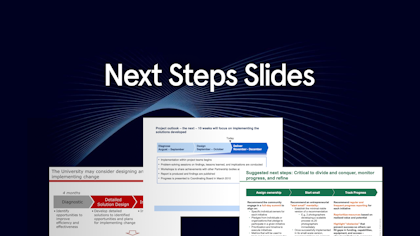
How to write a Next Steps slide (with Examples and Free Template)
In this blog post, we’ll dive into the Next Steps slide, why it’s important, and how to write one. We’ll also provide you with examples of Next Steps slides from McKinsey, BCG, and Bain, as well as a free template for you to create your own Next Steps slide.
Nov 1, 2024
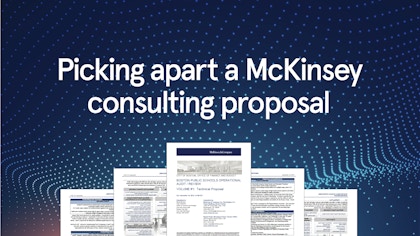
Picking apart a McKinsey consulting proposal
In this blog post, we’ll break down a McKinsey consulting proposal, look at what works and why, and discuss how to write a winning consulting proposal.
Oct 12, 2024

20 PowerPoint shortcuts every consultant must know
We surveyed a group of top-tier consultants and identified their top PowerPoint shortcuts. This post explains how to use them efficiently.
Sep 23, 2024

- Consulting Toolkit
- Market Entry Analysis
- Consulting Maps Bundle
- Mergers & Acquisitions
- Digital Transformation
- Product Strategy
- Go-To-Market Strategy
- Operational Excellence I
- Operational Excellence II
- Operational Excellence III
- Full Access Bundle
- Consulting PowerPoint Templates
- How it works
- Terms & Conditions
- Privacy Policy
© 2024 Slideworks. All rights reserved
Denmark : Farvergade 10 4. 1463 Copenhagen K
US : 101 Avenue of the Americas, 9th Floor 10013, New York

Master the 7-Step Problem-Solving Process for Better Decision-Making
Discover the powerful 7-Step Problem-Solving Process to make better decisions and achieve better outcomes. Master the art of problem-solving in this comprehensive guide. Download the Free PowerPoint and PDF Template.


StrategyPunk
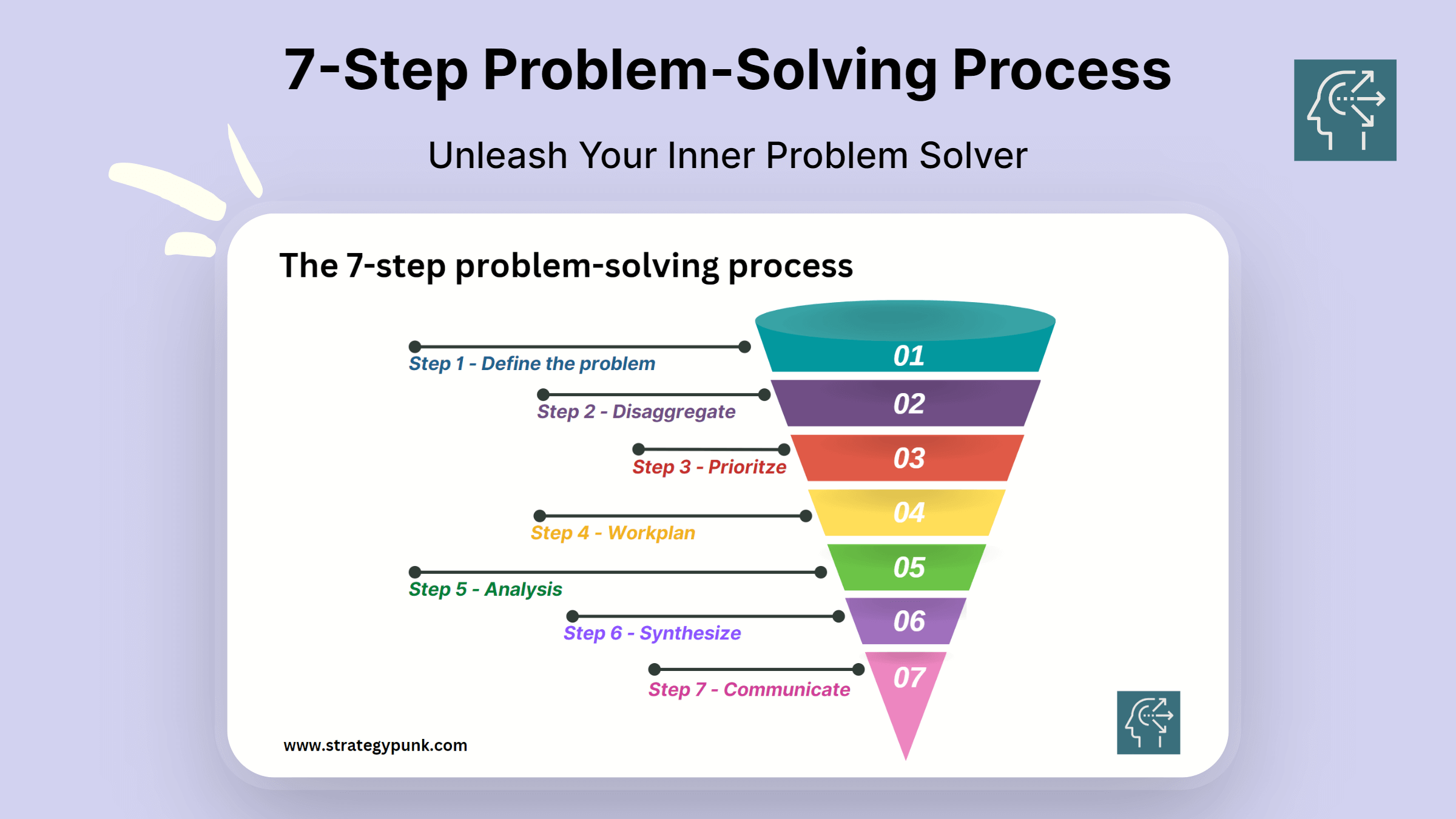
Introduction
Mastering the art of problem-solving is crucial for making better decisions. Whether you're a student, a business owner, or an employee, problem-solving skills can help you tackle complex issues and find practical solutions. The 7-Step Problem-Solving Process is a proven method that can help you approach problems systematically and efficiently.
The 7-Step Problem-Solving Process involves steps that guide you through the problem-solving process. The first step is to define the problem, followed by disaggregating the problem into smaller, more manageable parts. Next, you prioritize the features and create a work plan to address each. Then, you analyze each piece, synthesize the information, and communicate your findings to others.
By following this process, you can avoid jumping to conclusions, overlooking important details, or making hasty decisions. Instead, you can approach problems with a clear and structured mindset, which can help you make better decisions and achieve better outcomes.
In this article, we'll explore each step of the 7-Step Problem-Solving Process in detail so you can start mastering this valuable skill. You can download the process's free PowerPoint and PDF templates at the end of the blog post .
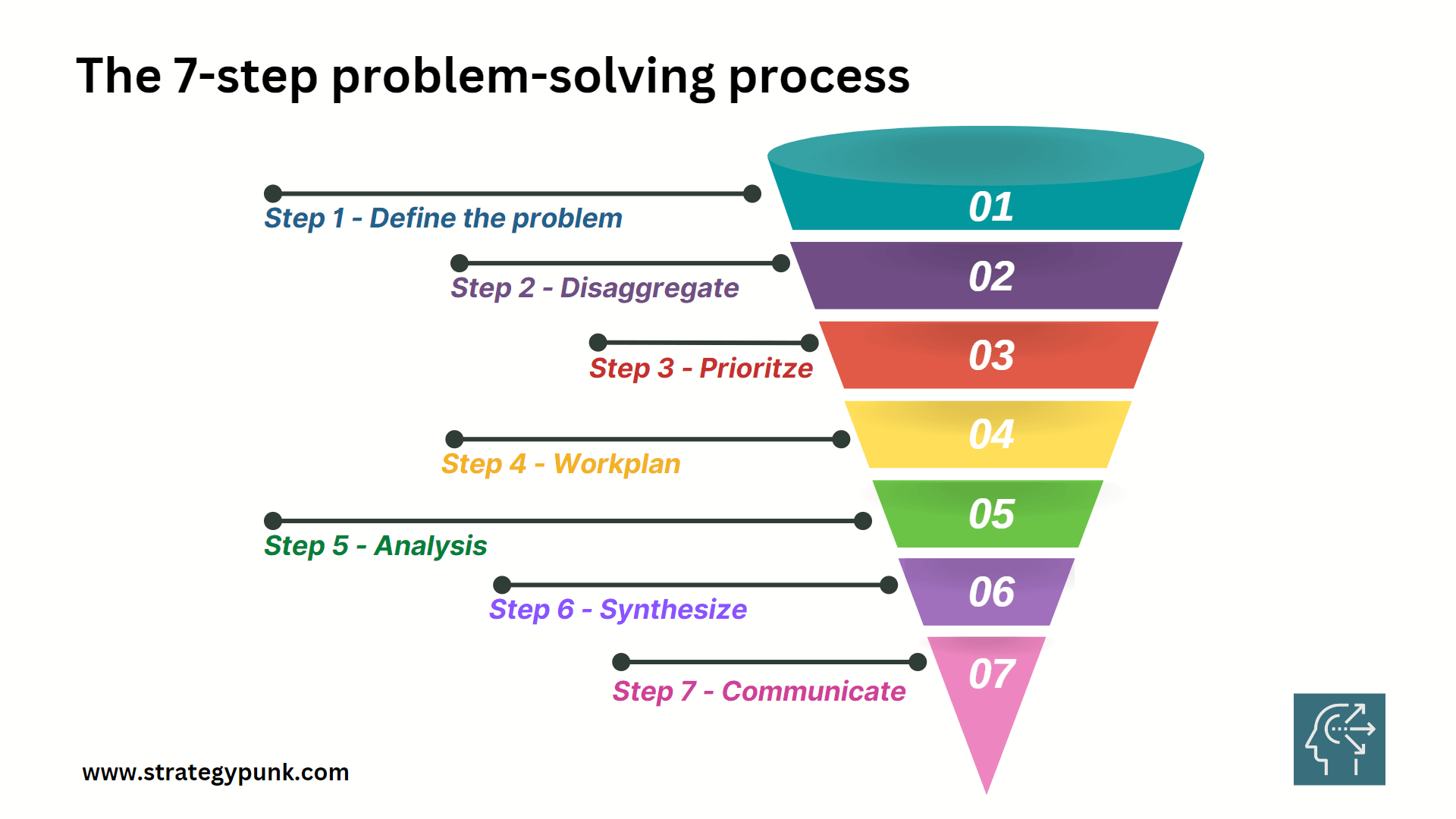
Step 1: Define the Problem
The first step in the problem-solving process is to define the problem. This step is crucial because finding a solution is only accessible if the problem is clearly defined. The problem must be specific, measurable, and achievable.
One way to define the problem is to ask the right questions. Questions like "What is the problem?" and "What are the causes of the problem?" can help. Gathering data and information about the issue to assist in the definition process is also essential.
Another critical aspect of defining the problem is identifying the stakeholders. Who is affected by it? Who has a stake in finding a solution? Identifying the stakeholders can help ensure that the problem is defined in a way that considers the needs and concerns of all those affected.
Once the problem is defined, it is essential to communicate it to all stakeholders. This helps ensure that everyone is on the same page and that there is a shared understanding of the problem.
Step 2: Disaggregate
After defining the problem, the next step in the 7-step problem-solving process is to disaggregate the problem into smaller, more manageable parts. Disaggregation helps break down the problem into smaller pieces that can be analyzed individually. This step is crucial in understanding the root cause of the problem and identifying the most effective solutions.
Disaggregation can be achieved by breaking down the problem into sub-problems, identifying the contributing factors, and analyzing the relationships between these factors. This step helps identify the most critical factors that must be addressed to solve the problem.
A tree or fishbone diagram is one effective way to disaggregate a problem. These diagrams help identify the different factors contributing to the problem and how they are related. Another way is to use a table to list the other factors contributing to the situation and their corresponding impact on the issue.
Disaggregation helps in breaking down complex problems into smaller, more manageable parts. It helps understand the relationships between different factors contributing to the problem and identify the most critical factors that must be addressed. By disaggregating the problem, decision-makers can focus on the most vital areas, leading to more effective solutions.
Step 3: Prioritize
After defining the problem and disaggregating it into smaller parts, the next step in the 7-step problem-solving process is prioritizing the issues that need addressing. Prioritizing helps to focus on the most pressing issues and allocate resources more effectively.
There are several ways to prioritize issues, including:
- Urgency: Prioritize issues based on their urgency. Problems that require immediate attention should be addressed first.
- Impact: Prioritize issues based on their impact on the organization or stakeholders. Problems with a high impact should be given priority.
- Resources: Prioritize issues based on the resources required to address them. Problems that require fewer resources should be dealt with first.
Considering their concerns and needs, it is important to involve stakeholders in the prioritization process. This can be done through surveys, focus groups, or other forms of engagement.
Once the issues have been prioritized, it is essential to develop a plan of action to address them. This involves identifying the required resources, setting timelines, and assigning responsibilities.
Prioritizing issues is a critical step in problem-solving. By focusing on the most pressing problems, organizations can allocate resources more effectively and make better decisions.
Step 4: Workplan
After defining the problem, disaggregating, and prioritizing the issues, the next step in the 7-step problem-solving process is to develop a work plan. This step involves creating a roadmap that outlines the steps needed to solve the problem.
The work plan should include a list of tasks, deadlines, and responsibilities for each team member involved in the problem-solving process. Assigning tasks based on each team member's strengths and expertise ensures the work is completed efficiently and effectively.
Creating a work plan can help keep the team on track and ensure everyone is working towards the same goal. It can also help to identify potential roadblocks or challenges that may arise during the problem-solving process and develop contingency plans to address them.
Several tools and techniques can be used to develop a work plan, including Gantt charts, flowcharts, and mind maps. These tools can help to visualize the steps needed to solve the problem and identify dependencies between tasks.
Developing a work plan is a critical step in the problem-solving process. It provides a clear roadmap for solving the problem and ensures everyone involved is aligned and working towards the same goal.
Step 5: Analysis
Once the problem has been defined and disaggregated, the next step is to analyze the information gathered. This step involves examining the data, identifying patterns, and determining the root cause of the problem.
Several methods can be used during the analysis phase, including:
- Root cause analysis
- Pareto analysis
- SWOT analysis
Root cause analysis is a popular method for identifying the underlying cause of a problem. This method involves asking a series of "why" questions to get to the root cause of the issue.
Pareto analysis is another method that can be used during the analysis phase. This method involves identifying the 20% of causes responsible for 80% of the problems. By focusing on these critical causes, organizations can make significant improvements.
Finally, SWOT analysis is a valuable tool for analyzing the internal and external factors that may impact the problem. This method involves identifying the strengths, weaknesses, opportunities, and threats related to the issue.
Overall, the analysis phase is critical for identifying the root cause of the problem and developing practical solutions. Organizations can gain a deeper understanding of the issue and make informed decisions by using a combination of methods.
Step 6: Synthesize
Once the analysis phase is complete, it is time to synthesize the information gathered to arrive at a solution. During this step, the focus is on identifying the most viable solution that addresses the problem. This involves examining and combining the analysis results for a clear and concise conclusion.
One way to synthesize the information is to use a decision matrix. This involves creating a table that lists the potential solutions and the essential criteria for making a decision. Each answer is then rated against each standard, and the scores are tallied to arrive at a final decision.
Another approach to synthesizing the information is to use a mind map. This involves creating a visual representation of the problem and the potential solutions. The mind map can identify the relationships between the different pieces of information and help prioritize the solutions.
During the synthesis phase, it is vital to remain open-minded and consider all potential solutions. Involving all stakeholders in the decision-making process ensures that everyone's perspectives are considered.
Step 7: Communicate
After synthesizing the information, the next step is communicating the findings to the relevant stakeholders. This is a crucial step because it helps to ensure that everyone is on the same page and that the decision-making process is transparent.
One effective way to communicate the findings is through a well-organized report. The report should include the problem statement, the analysis, the synthesis, and the recommended solution. It should be clear, concise, and easy to understand.
In addition to the report, a presentation explaining the findings is essential. The presentation should be tailored to the audience and highlight the report's key points. Visual aids such as tables, graphs, and charts can make the presentation more engaging.
During the presentation, it is essential to be open to feedback and questions from the audience. This helps ensure everyone agrees with the recommended solution and addresses concerns or objections.
Effective communication is vital to ensuring the success of the decision-making process. By communicating the findings clearly and concisely, stakeholders can make informed decisions and work towards a common goal.
The 7-step problem-solving process is a powerful tool for helping individuals and organizations make better decisions. By following these steps, individuals can identify the root cause of a problem, prioritize potential solutions, and develop a clear plan of action. This process can be applied to various scenarios, from personal challenges to complex business problems.
Through disaggregation, individuals can break down complex problems into smaller, more manageable parts. By prioritizing potential solutions, individuals can focus their efforts on the most impactful actions. The work step allows individuals to develop a clear action plan, while the analysis step provides a framework for evaluating possible solutions.
The synthesis step combines all the information gathered to develop a comprehensive solution. Finally, the communication step allows individuals to share their answers with others and gather feedback.
By mastering the 7-step problem-solving process, individuals can become more effective decision-makers and problem-solvers. This process can help individuals and organizations save time and resources while improving outcomes. With practice, individuals can develop the skills to apply this process to a wide range of scenarios and make better decisions in all areas of life.
7-Step Problem-Solving Process PPT Template
Free powerpoint and pdf template, executive summary: the 7-step problem-solving process.
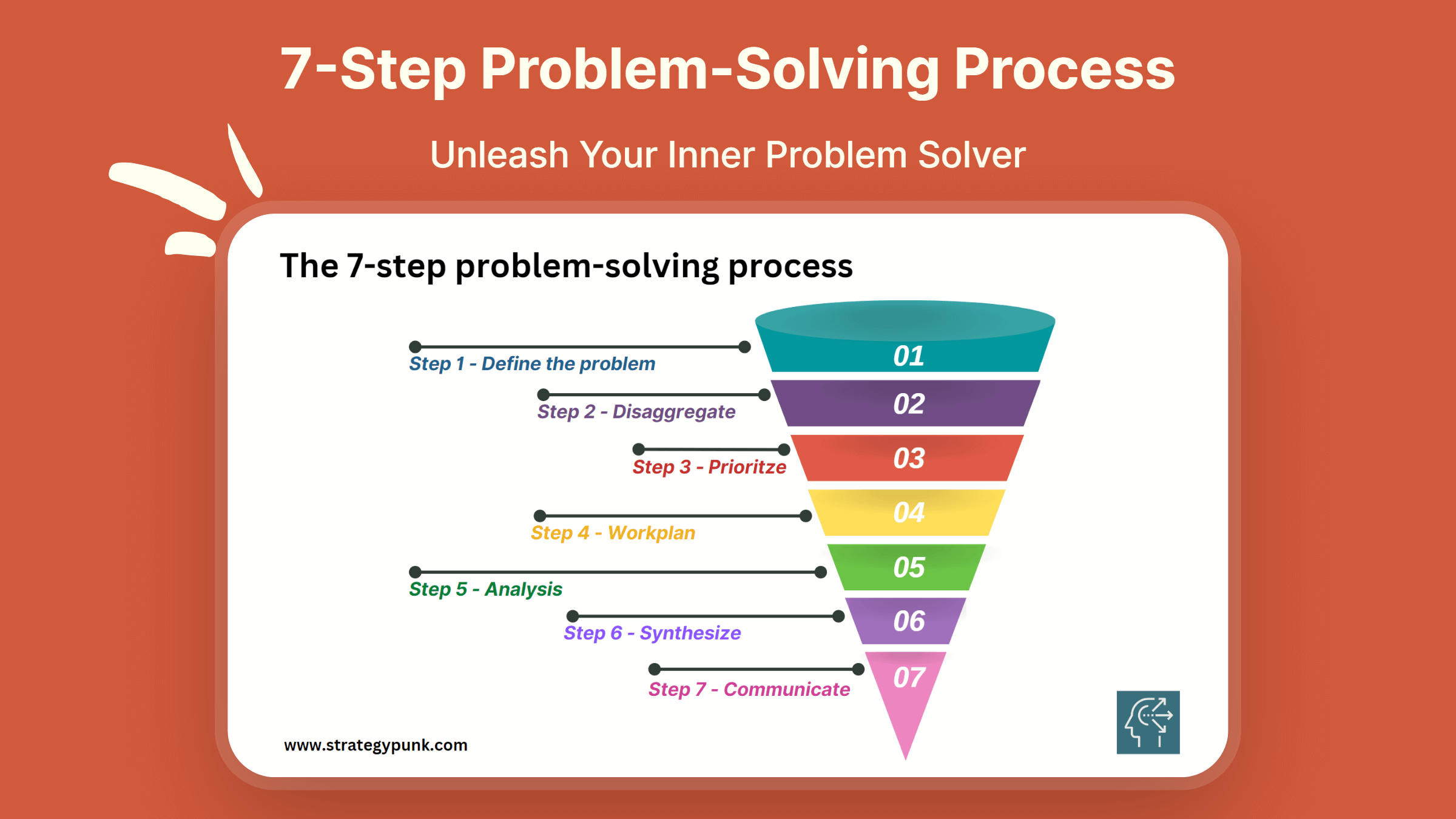
The 7-Step Problem-Solving Process is a robust and systematic method to help individuals and organizations make better decisions by tackling complex issues and finding practical solutions. This process comprises defining the problem, disaggregating it into smaller parts, prioritizing the issues, creating a work plan, analyzing the data, synthesizing the information, and communicating the findings.
By following these steps, individuals can identify the root cause of a problem, break it down into manageable components, and prioritize the most impactful actions. The work plan, analysis, and synthesis steps provide a framework for developing comprehensive solutions, while the communication step ensures transparency and stakeholder engagement.
Mastering this process can improve decision-making and problem-solving capabilities, save time and resources, and improve outcomes in personal and professional contexts.
Sign up for StrategyPunk
Every Organization Needs a Strategy. Unlock Free Insights and Templates to Master Yours. Join 5000+ Leaders Today.
No spam. Unsubscribe anytime.
7-Step Problem-Solving Process PDF Template
7-step problem-solving process powerpoint template.
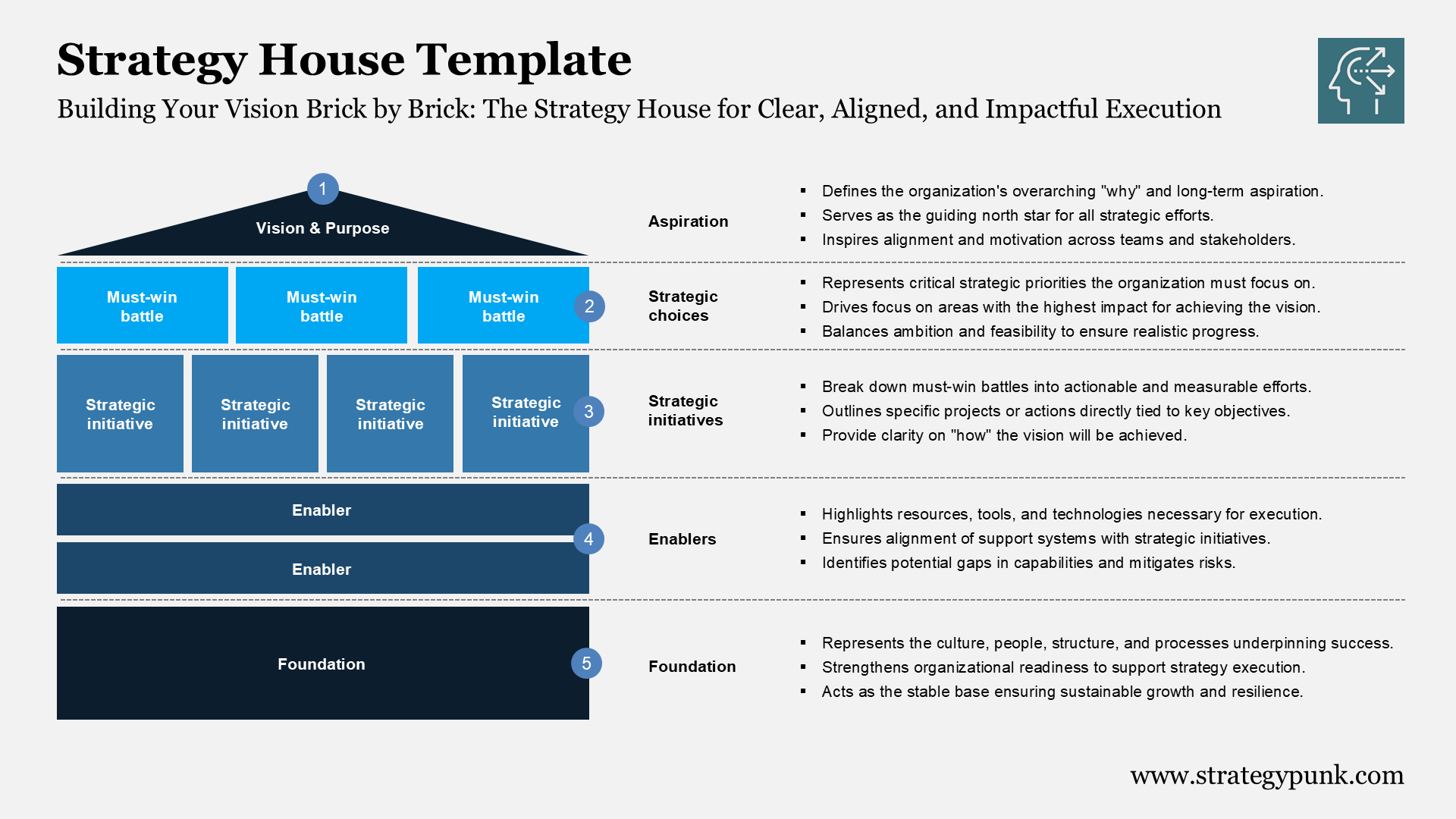
Harness the Infamous Strategy House Used by McKinsey, Bain, and BCG (Free Template)
Master the Strategy House Framework! Learn how to align your team & goals. Download our free PDF & PPT template now!

PESTLE Analysis: Airbnb (FREE PDF Template)
Discover Airbnb's vision, strategy, and a detailed PESTLE analysis. Download our free PDF for insights on Airbnb's growth and global impact.

PESTLE Analysis of TSMC (FREE PDF Template)
Download a free PDF PESTLE analysis of TSMC's latest annual report, including a company introduction and strategy description.
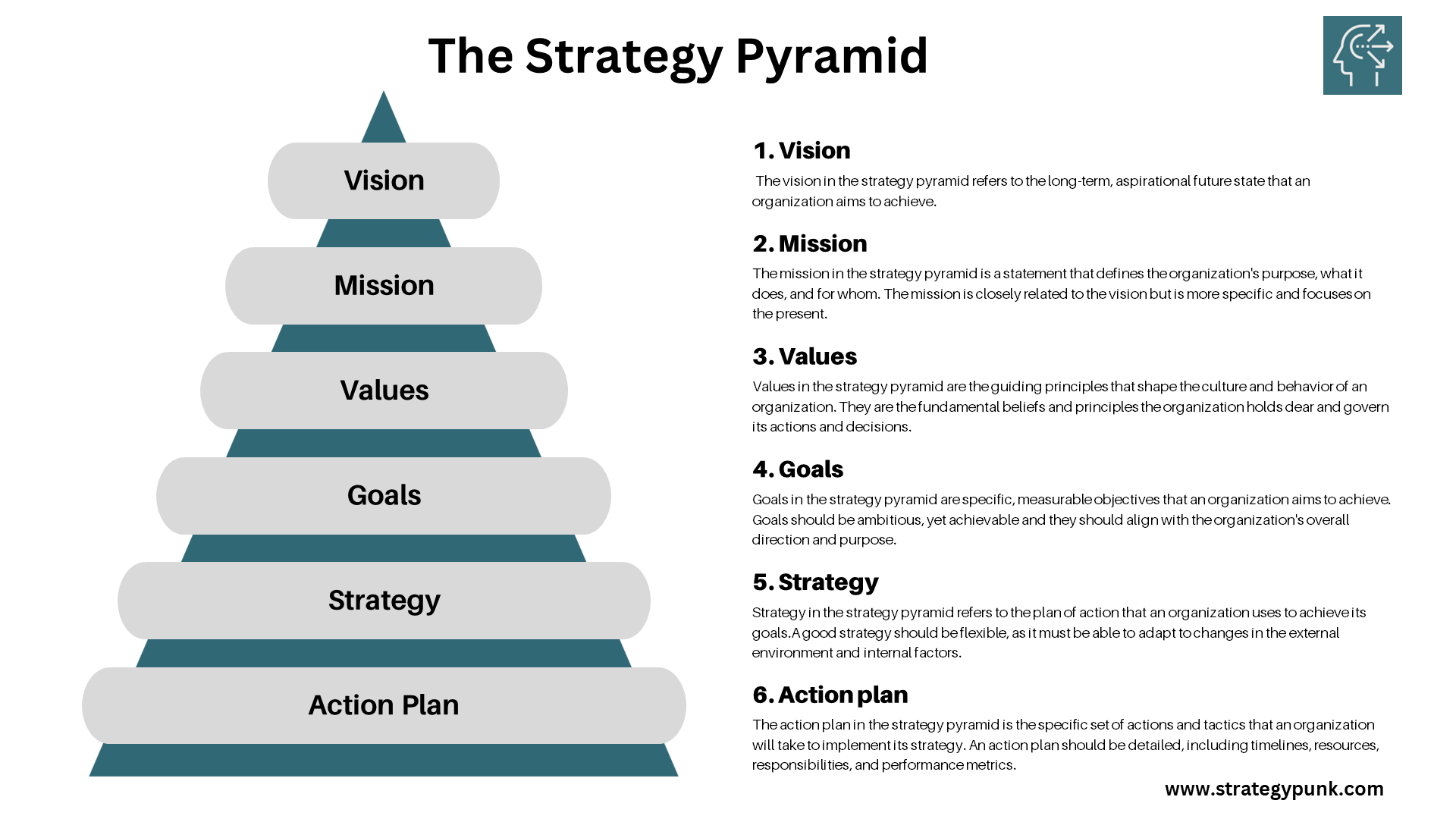
Strategic Planning with The Strategy Pyramid (Free Powerpoint)
Strategic Planning with The Strategy Pyramid (Free Powerpoint). The strategy pyramid is a framework that helps organizations align their actions with their overall vision and mission.

IMAGES
VIDEO